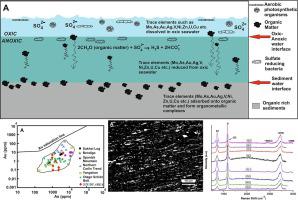当前位置:
X-MOL 学术
›
Ore Geol. Rev.
›
论文详情
Our official English website, www.x-mol.net, welcomes your feedback! (Note: you will need to create a separate account there.)
Characterization of organic matter and its implications for pyrite hosted refractory gold mineralization along the South Purulia Shear Zone, eastern India
Ore Geology Reviews ( IF 3.3 ) Pub Date : 2020-09-01 , DOI: 10.1016/j.oregeorev.2020.103584 Subhashree Majumdar , Sahendra Singh , Prabodha Ranjan Sahoo
Ore Geology Reviews ( IF 3.3 ) Pub Date : 2020-09-01 , DOI: 10.1016/j.oregeorev.2020.103584 Subhashree Majumdar , Sahendra Singh , Prabodha Ranjan Sahoo

|
Abstract Refractory gold bearing sulphide mineralization is spatially associated with the carbonaceous matter rich meta-sedimentary rocks of the Proterozoic South Purulia Shear Zone (SPSZ). The carbon rich layers occurring as black, continuous laminae are the metamorphosed derivatives of carbonaceous matter, which were originally present in the sedimentary rocks and bear the characteristics of initial sedimentary environment of the refractory gold bearing formations of SPSZ. The carbonaceous laminae aligned along the bedding/foliation planes got remobilized into the sulfide bearing quartz ± carbonate veins during the metamorphic and deformational events. The typical disordered bands as well as graphitic band in the Raman spectra indicate that the carbonaceous matter is partially graphitized from the precursor carbon rich layers. The light and homogeneous carbon isotopic values (δ13C = -26.7 to -28.2 ‰) of the graphitized carbon suggests its origin due to the evolution from an organic precursor. The δ13C values fall within the range typical for organic carbon deposited during the Paleo to Meso-proterozoic period. The organic matter is considered to have played an essential role in buffering the oxygen fugacity of the initial sedimentary basin. The dissolved sulfate ions in seawater were reduced resulting in sulfidation and adsorption of Au in sedimentary pyrites to form refractory gold. Later during the deformational stages, the hydrothermal fluids interacted with the graphitized matter which provided suitable redox conditions for the precipitation of auriferous sulfides such as pyrite, pyrrhotite, chalcopyrite and arsenopyrite within the quartz ± carbonate veins.
中文翻译:

印度东部南普鲁利亚剪切带的有机质特征及其对黄铁矿难熔金矿化的影响
摘要 难熔含金硫化物矿化在空间上与元古界南普鲁利亚剪切带(SPSZ)富含碳质的变质沉积岩有关。以黑色连续薄片形式出现的富碳层是碳质物质的变质衍生物,最初存在于沉积岩中,具有SPSZ难熔含金地层初始沉积环境的特征。在变质和变形事件期间,沿层理/叶理平面排列的碳质层重新迁移到含硫化物的石英±碳酸盐脉中。拉曼光谱中典型的无序带和石墨带表明含碳物质部分石墨化来自前体富碳层。石墨化碳的轻质和均质碳同位素值(δ13C = -26.7 至 -28.2 ‰)表明其起源于有机前体的演化。δ13C 值落在古到中元古代时期沉积的有机碳的典型范围内。有机质被认为在缓冲初始沉积盆地的氧逸度方面发挥了重要作用。海水中溶解的硫酸根离子被还原,导致沉积黄铁矿中的Au硫化和吸附,形成难熔的金。在变形阶段的后期,热液流体与石墨化物质相互作用,为石英±碳酸盐脉内黄铁矿、磁黄铁矿、黄铜矿和毒砂等含金硫化物的沉淀提供了合适的氧化还原条件。
更新日期:2020-09-01
中文翻译:

印度东部南普鲁利亚剪切带的有机质特征及其对黄铁矿难熔金矿化的影响
摘要 难熔含金硫化物矿化在空间上与元古界南普鲁利亚剪切带(SPSZ)富含碳质的变质沉积岩有关。以黑色连续薄片形式出现的富碳层是碳质物质的变质衍生物,最初存在于沉积岩中,具有SPSZ难熔含金地层初始沉积环境的特征。在变质和变形事件期间,沿层理/叶理平面排列的碳质层重新迁移到含硫化物的石英±碳酸盐脉中。拉曼光谱中典型的无序带和石墨带表明含碳物质部分石墨化来自前体富碳层。石墨化碳的轻质和均质碳同位素值(δ13C = -26.7 至 -28.2 ‰)表明其起源于有机前体的演化。δ13C 值落在古到中元古代时期沉积的有机碳的典型范围内。有机质被认为在缓冲初始沉积盆地的氧逸度方面发挥了重要作用。海水中溶解的硫酸根离子被还原,导致沉积黄铁矿中的Au硫化和吸附,形成难熔的金。在变形阶段的后期,热液流体与石墨化物质相互作用,为石英±碳酸盐脉内黄铁矿、磁黄铁矿、黄铜矿和毒砂等含金硫化物的沉淀提供了合适的氧化还原条件。



























 京公网安备 11010802027423号
京公网安备 11010802027423号